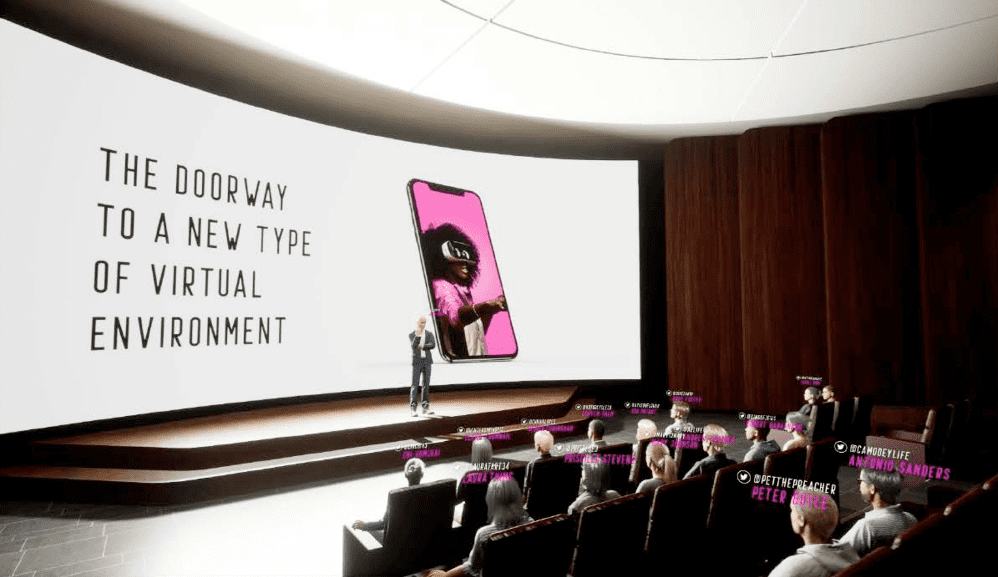“One of the biggest problems with the world today is that we have large groups of people who will accept whatever they hear on the grapevine, just because it suits their worldview—not because it is actually true or because they have evidence to support it. The really striking thing is that it would not take much effort to establish validity in most of these cases… but people prefer reassurance to research.”
– Dr. Neil deGrasse Tyson

The Future 'Verse
Although enthusiasm for the metaverse has cooled in recent months, the technology and experience remains poised to reshape our digital future. Virtual worlds have the potential to play a significant role in how we learn, interact, work and play.
With analysts predicting the market for metaverse technologies will reach $1.52tn by 2029 and add $760bn to US GDP by 2035, it’s understandable—and perhaps predictable—that some brands are eager to launch their own metaverse products in the shortest possible time.
But it’s not enough to merely show up. Businesses need to start with a coherent, thoughtful, and end-to-end metaverse strategy. A strategy that doesn’t merely consider the business objectives and perspectives of stakeholders, but also the user experience and how the product will evolve throughout its lifecycle. Without a clear understanding of these points, any virtual world is doomed to fail.
Engagement is the ‘WHAT’
Although the metaverse isn’t a new concept, it achieved widespread awareness during the earliest years of the Covid-19 pandemic, when there was an evident need for an environment that could meaningfully replicate human-to-human interactions in cyberspace.
With schools, workplaces, and retail stores closed indefinitely, the idea that people could—leveraging the latest advances in virtual reality (VR) and extended reality (XR) technology—achieve some degree of normality was a tantalizing prospect. Metaverse excitement, exploration, and hype persisted even as governments lifted lockdown restrictions, with Facebook rebranding to Meta in early-2021 in reflection of its new direction, and Microsoft acquiring Activision-Blizzard to strengthen its hand.
In the years that followed, the metaverse hype bubble slowly evened out. As macroeconomic conditions declined, some of its earliest enthusiasts began to scale back their metaverse investments. Generative AI—which entered the mainstream in late-2022 with ChatGPT—stole much of its momentum, as well as the tech industry’s attention.
This softening of enthusiasm, which Gartner notably describes as the “trough of disillusionment,” wasn’t unexpected. Even the most bullish metaverse advocates acknowledged that it mirrored the same trajectory as other innovations like the internet and the smartphone and would take several years to transition from consumer and enterprise ‘try,’ to ‘want,’ and eventually ‘need.’ The metaverse ecosystem has made it through the initial hype stage, but is still very much in its infancy and will need time to mature and manage widespread adoption.
Despite the long road ahead, brands and companies should explore the metaverse. As the earliest metaverse experiments demonstrate, well-crafted experiences can deliver tangible business results, particularly with respect to user engagement and memorability.
Flipkart—a major Indian e-commerce platform—attracted over 100,000 unique users to its inaugural metaverse experience over a seven-day period, with visitors lingering for 7.5-10 minutes on average.
Celebrity Cruises achieved similar levels of success, drawing 6,000 users in a single day, each dwelling for 26.5 minutes on average. These impressive figures demonstrate the metaverse’s incredible potential as a tool for branding and marketing. But to replicate this success, organizations need to start from a position of clarity, understanding not only the underlying platforms and their demographics, but also how to measure and align these realities with their ambitions and objectives.

The Metaverse Can TAKE ON MANY FORMS
There’s no one correct definition of the metaverse. On a basic level, the term describes an immersive 3D world where users can interact with other players, as well as the broader environment. Metaverses can facilitate activities that otherwise wouldn’t be possible in the physical realm. These activities can range from the spectacular to the familiar: from attending a concert with hundreds of thousands of global players, to visiting a car dealership belonging to a company yet to establish a widespread retail presence.
The variety of experiences means that each metaverse platform differs significantly in its implementation. Even within gaming-centric platforms, there’s an incredible array of diversity.
Many, notably Roblox and Fortnite, treat gameplay as the main priority. Some, like Meta’s Horizon Worlds, are walled gardens, whereas others, notably Decentraland, are thriving (and often chaotic) open worlds.
Brands must keenly understand the differences between platforms, their capabilities and limitations, and their demographics.
Some of the most successful metaverse activations have occurred within the gaming world, which offers brands a vast built-in audience. Fortnite, for example, boasts an estimated 80m monthly users. Because these gaming platforms frequently adopt a free-to-play model, where users pay for in-game currencies and assets through microtransactions, users are conditioned to spend on items that augment or complement the gaming experience.
NOTE: secondary revenue has exploded and earnings for players, starting with Twitch and now actual Gaming “leagues” with sponsored players.
These factors bode well for brands and companies, but have caveats worth noting. Because these platforms prioritize gaming, they may not provide the metrics your organization needs to measure the reach and efficacy of a campaign. Moreover, their demographics skew young, with an estimated two-thirds of Fortnite users aged between 18 and 24. And so, they may fail to capture your experience’s target audience.
Moreover, metaverse platforms can be divided further into the “open world” and “walled garden” categories. Walled gardens—of which Meta’s Horizon Worlds is a leading example—typically provide brands and organizations with the flexibility and tools to craft engaging, high-fidelity experiences. But they’re also incredibly demanding, requiring large amounts of upfront effort, compelling IP, and a long-term commitment.
Open-world platforms like Decentraland have a proven track record as a home for brand activations and events. Its 2023 Metaverse Fashion Week attracted established names like Tommy Hilfiger, Paco Rabanne, and Adidas.
But these open-world metaverses aren’t without their limitations. Questions linger about the accuracy of traffic numbers. Moreover, platform “real estate” can prove incredibly costly. The Decentraland universe has a total of 90,601 plots of land, which introduces an element of artificial scarcity and speculation, much like the real-world property market. Prices can vary based on a number of factors, from availability to desirability, to floor-size and the ‘frothiness’ of the cryptocurrency market.
When embarking upon a metaverse project, businesses and brands should consider how their chosen platforms align with their objectives, paying keen attention to demographics and technical capabilities. In the absence of open standards that would allow for the interoperability of virtual worlds, these factors demand careful thought.
The Metaverse Is Difficult
Marketing, by its very nature, is a highly agile business, with campaigns launched at short notice in response to emerging consumer trends. By contrast, building a metaverse experience can be an expensive and highly-involved process. Developing functional, utility-driven, and immersive multiplayer experiences takes time—and a significant upfront investment.
Depending on its sophistication and scale, a custom solution can cost up to $2m and take over 18 months to build. The metaverse is an emerging technology and the tools that allow for the rapid prototyping, development, and real-time management of metaverse experiences simply do not exist at this stage.
Although brands should remain cognizant of the costs and effort associated with metaverse development, they shouldn’t neglect the elements essential to its long-term success. The things that lead to enduring user engagement—like channel management, staffing, events and promotions, and regular new content—require serious thought and investment.
Likewise, while community-building is tough, there are ways to simplify the process. These range from the fundamentals, like leveraging high-fidelity visual assets and compelling game loops, to using programmatic content and events to ensure there’s always an element of novelty. A sound metaverse strategy doesn’t just focus on attracting users but considers how to keep them coming back for more.
Companies Need a Roadmap
The metaverse is widely misunderstood. Its evangelists and critics are numerous, though they are equally vocal. But it’s also the future of interaction and immersion. Despite its headwinds, there remains significant cause for optimism — from the ongoing commercial interest, to the vibrancy of the platforms themselves, and the formidable results achieved by the earliest commercial adopters.
Today, the most prolific metaverse users are those in Gen Z, which spends twice as much time socializing in virtual worlds as in real life. This demographic will probably represent the core metaverse user base for the near-to-medium term, and any strategy should consider their perspectives and sensibilities.
Furthermore, just like millennials grew up on social media, Gen Z and Gen Alpha’s most formative experiences will take place on the metaverse, and so they’ll have an instinctive awareness for content that’s low-quality or inauthentic. For brands, these groups are their biggest opportunity, and their biggest threat.
As Julie Arbit, Global SVP of Insights at Vice, explained: “Gen Z is using the metaverse to cultivate connections and explore who they really are. It allows them to dream and co-create a more idealized version of the world. Brands would be remiss to not include the metaverse as a strategic piece of their initiatives, provided they do so in a way that both respects and enhances the overall experience.”
Authenticity can’t be faked. It requires thought and hard work, paired with a holistic strategy that encompasses every facet of the experience’s lifecycle, and treats the user experience as of equal importance to the broader business objectives. By their very nature, a metaverse strategy should be multifaceted and consider the following points:
• Customer Experience
• Community Engagement
• Monetization & Commerce
• Planning Continuity
• Technology Integration & Roadmap
• Marketing, Promotion, & Brand Development
• Content, Events, & Programming
• Sponsorship & Partnerships
• Research & Development
• Metrics & Analytics

As you consider each point, it’s worth asking hard questions about the fundamentals of your project. Who is it for? What does success look like? What is our target audience and how can we reach them? How quickly can we pivot or iterate? How do we translate attention into ROI? What are our long-term plans for content? How can we scale? What are the biggest obstacles to implementation and commercialization?
Taking the time to THINK
Excitement surrounding the metaverse has cooled, but it will rise again. But before that time comes, companies should take this moment of relative calm to think seriously about their metaverse ambitions, and how to build an experience that aligns with their business objectives and brand.
Oscar Wilde once said: “There is only one thing in life worse than being talked about, and that is not being talked about.” Brands that treat the metaverse as a gold rush, hastily pushing out half-baked experiences and products, are doomed to suffer the ignominy of user apathy. They may get a few first-day visits, but most will leave, and few will return.

The metaverse can deliver memorability, stickiness, and high user engagement levels. But to achieve them, brands need to take the time to consider their strategy, their audience, and what sets them apart from the rest.
The good news is that the metaverse is right where it should be on the technology adoption curve. Similar to its innovation predecessors (i.e. the internet, smartphones, etc.) and its contemporaries (i.e. AI) it needs to make it through the gauntlet of consumer expectations and enterprise ROI.
We don’t know what the ‘killer experience’ will be, but early adopters are more creative than ever and we are poised to see and experience use cases we never thought of when the first metaverse launched.
All of this to say, there is a fundamental shift that we cannot afford to ignore. The metaverse enables forward-thinking businesses, brands and individuals solutions to amplify engagement, accelerate sales cycles, broaden access and participation, and improve collaboration through immersion. Moreover, the metaverse enables creators to produce always-on experiences simultaneously free of the limitations of time, location, cost or carbon footprint.
Our next article will take a closer look at early metaverse implementations followed by how we see the space evolving and how it is defining and creating new market categories.



